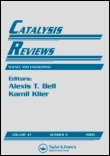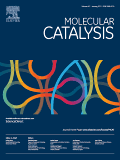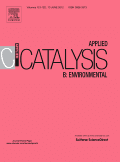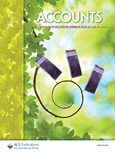
CATALYSIS REVIEWS-SCIENCE AND ENGINEERING
Scope & Guideline
Exploring Breakthroughs in Catalytic Science and Technology
Introduction
Aims and Scopes
- Catalytic Mechanisms and Reaction Pathways:
The journal emphasizes the exploration of catalytic mechanisms and the detailed pathways of reactions, often focusing on the molecular and atomic-level interactions that govern catalytic processes. - Sustainable and Green Catalysis:
A core focus is on sustainable catalytic processes that minimize environmental impact, including the development of catalysts for biomass conversion, CO2 utilization, and other renewable feedstocks. - Advancements in Catalytic Materials:
The journal showcases innovative materials used in catalysis, such as nanostructured materials, biocatalysts, and metal-organic frameworks, highlighting their synthesis, characterization, and application. - Electrocatalysis and Photocatalysis:
A significant area of interest is the development of catalysts for electrochemical and photocatalytic processes, with a focus on energy conversion and pollutant degradation. - Machine Learning and Computational Catalysis:
The integration of machine learning and computational methods in catalyst design and optimization is increasingly prominent, allowing for predictive modeling and enhanced understanding of catalytic systems.
Trending and Emerging
- Electrocatalytic CO2 Reduction:
There is a growing interest in electrocatalytic processes for CO2 reduction to valuable chemicals, driven by the need for carbon neutrality and sustainable energy solutions. - Biocatalysis and Enzymatic Reactions:
The application of biocatalysts and enzyme-based reactions is on the rise, particularly in the context of green chemistry and sustainable production of chemicals. - Machine Learning in Catalysis:
The increasing use of machine learning techniques to predict and optimize catalytic performance is emerging as a significant trend, facilitating the design of novel catalysts and reaction pathways. - Nanostructured and Two-Dimensional Catalysts:
Research on nanostructured materials, including two-dimensional materials like graphene and transition metal dichalcogenides, is gaining momentum due to their unique properties and potential applications in catalysis. - Catalytic Processes for Wastewater Treatment:
Emerging themes include the development of catalytic processes aimed at treating wastewater and removing contaminants, which is increasingly critical in environmental catalysis.
Declining or Waning
- Traditional Homogeneous Catalysis:
There has been a noticeable decrease in reviews focusing on traditional homogeneous catalysis, as more emphasis is placed on heterogeneous and biocatalytic systems that offer greater sustainability and efficiency. - Classic Metal Catalysts:
Research on classical metal catalysts, particularly those based on noble metals without innovative approaches or modifications, appears to be waning. The field is moving towards more sustainable and earth-abundant metal catalysts. - Thermal Catalysis without Green Considerations:
The focus on thermal catalytic processes without integrating green chemistry principles is diminishing, as the community increasingly prioritizes environmentally friendly methodologies. - Conventional Organic Synthesis Techniques:
Topics centered around conventional organic synthesis methods are less frequently reviewed, as the field shifts toward more innovative and efficient catalytic approaches that offer higher selectivity and lower environmental impact.
Similar Journals

Molecular Catalysis
Transforming Challenges into Catalytic SolutionsMolecular Catalysis, published by Elsevier in Netherlands, is a premier academic journal that explores the cutting-edge domain of catalytic science. With an impressive impact factor and classified in the top quartiles (Q2) in various fields such as Catalysis, Physical and Theoretical Chemistry, and Process Chemistry and Technology, this journal stands as a significant resource for researchers and professionals committed to advancing the understanding of catalysis processes. Since its inception in 2017, it has been pivotal in publishing high-quality, peer-reviewed research that addresses crucial challenges and innovations in molecular catalysis. The journal is fully Open Access, allowing unrestricted access to its articles, thus fostering a wider dissemination of knowledge. Recognized for its rigorous editorial standards, it features works that push the boundaries of current scientific understanding, making it an essential platform for students and academics alike to share and grow in their expertise.

KINETICS AND CATALYSIS
Unveiling Mechanisms, Inspiring BreakthroughsKinetics and Catalysis is a pioneering journal dedicated to advancing the field of catalytic science and chemical kinetics, published by Pleiades Publishing Inc. Based in the Russian Federation, this journal serves as a critical platform for disseminating high-quality research related to the mechanisms of chemical reactions and innovative catalytic processes. Although currently not an open access journal, it maintains academic rigor through a comprehensive peer-review process that ensures the relevance and integrity of its published works. With a history dating back to 1968, Kinetics and Catalysis has evolved through various converged years, reflecting its commitment to interdisciplinary research within the realms of chemistry, catalysis, and the computational aspects of modeling and simulation. As evidenced by its Scopus rankings and quartiles, it stands as an influential, albeit niche, journal, appealing to researchers, professionals, and students eager to explore the intricacies of chemical transformations. The journal’s robust archive offers an invaluable resource for those seeking to expand their understanding of both theoretical and practical approaches to catalysis.

CCS Chemistry
Connecting Researchers with Cutting-Edge Chemical InsightsCCS Chemistry, published by the esteemed Chinese Chemical Society, is a leading open-access journal dedicated to advancing the field of chemistry. Since its inception in 2019, the journal has rapidly gained recognition, achieving a remarkable impact factor that places it in the prestigious Q1 category in Chemistry (Miscellaneous) as of 2023. With a Scopus ranking of #41 out of 408 in General Chemistry, CCS Chemistry represents the top 10th percentile in its category, reflecting its commitment to high-quality research and innovation. The journal serves as a vital platform for researchers and professionals to share their findings, showcase cutting-edge methodologies, and engage with the latest developments in various chemistry subfields. Accessible to a global audience, CCS Chemistry ensures that groundbreaking research is available without barriers, making it an indispensable resource for students and academics aiming to stay at the forefront of chemical sciences. For further details, submissions, and access to published articles, please visit the journal's website.

Applied Catalysis B-Environment and Energy
Empowering researchers to shape a cleaner, energy-efficient world.Applied Catalysis B-Environment and Energy, published by Elsevier, is a leading journal in the fields of catalysis, environmental science, and process chemistry, with an impressive impact factor that reflects its significance in advancing research and innovation. Established in 1992, this esteemed journal has earned a prestigious status as evidenced by its 2023 category quartiles—ranking in the Q1 category for Catalysis, Environmental Science, and Process Chemistry and Technology. With consistently high rankings in the Scopus database, it holds a remarkable position as #1 in General Environmental Science and #2 in both Process Chemistry and Catalysis, showcasing its profound impact on the respective fields. The journal’s scope encompasses both theoretical and practical research, targeting the pivotal developments in catalysis that promote sustainable practices and energy efficiency. Researchers, professionals, and students alike will find invaluable insights and cutting-edge studies published within its pages, making it an essential resource for those invested in pioneering advancements for a greener, more energy-efficient future.

ADVANCED SYNTHESIS & CATALYSIS
Unleashing potential through cutting-edge methodologies.ADVANCED SYNTHESIS & CATALYSIS is a prestigious academic journal published by Wiley-VCH Verlag GmbH, based in Germany. This journal, with ISSN 1615-4150 and E-ISSN 1615-4169, plays a pivotal role in the fields of Chemistry and Chemical Engineering, earning commendable rankings such as Q2 in Catalysis and Q1 in Organic Chemistry in 2023. Its high impact factor and recognition—ranking #18 in both Organic Chemistry and Catalysis—further underscore its significance as a platform for groundbreaking research and innovative methodologies. Spanning from 1996 through 2024, ADVANCED SYNTHESIS & CATALYSIS aims to disseminate high-quality, cutting-edge studies related to synthetic processes and catalytic technologies, ensuring accessibility via their open access options. By fostering a vibrant scholarly community, this journal serves as an essential resource for researchers, professionals, and students dedicated to driving advancements in synthetic and catalytic chemistry.

Chemical Science
Connecting Minds, Inspiring ChemistryChemical Science, published by the esteemed Royal Society of Chemistry, is a leading open-access journal that has been a pivotal platform for disseminating high-quality research in the field of chemistry since its inception in 2010. With an impressive Impact Factor and ranked in the Q1 category of Chemistry (miscellaneous) and holding a distinguished rank of #34 out of 408 in General Chemistry according to Scopus, it is widely recognized for its rigorous peer-review process and innovative contributions to the discipline. The journal embraces a global readership by providing an open-access model since 2015, thereby making vital scientific advancements accessible to researchers, professionals, and students alike. Covering various branches of chemistry, Chemical Science aims to publish original research articles, reviews, and communications that advance our understanding and application of chemical sciences. With its commitment to excellence and its continued relevance in a rapidly evolving field, Chemical Science is an indispensable resource for anyone engaged in chemistry research and education.

ACCOUNTS OF CHEMICAL RESEARCH
Exploring the Synergy of Chemical Research and HealthcareACCOUNTS OF CHEMICAL RESEARCH, published by the American Chemical Society, is a premier journal dedicated to advancing the field of chemistry and its applications in medicine. With an impressive impact factor and recognition as a Q1 journal in both chemistry and medicine categories, it ranks among the top-tier publications, exhibiting an outstanding Scopus rank of 8 out of 408 in general chemistry, placing it in the 98th percentile. This journal has been a vital source of innovative and significant research since its inception in 1968, and it aims to provide a platform for high-quality research articles, reviews, and critical essays that bridge the gap between chemical research and clinical implications. While it is not an open-access publication, the insights available in Accounts of Chemical Research are invaluable for researchers, professionals, and students seeking to explore the latest developments and interdisciplinary approaches within the dynamic fields of chemistry and medicine.

CATALYSIS COMMUNICATIONS
Uniting Experts in the Quest for Catalytic ExcellenceCATALYSIS COMMUNICATIONS is a prestigious journal published by Elsevier, focusing on advancements in the field of catalysis, an essential component of chemical engineering and process technology. With an ISSN of 1566-7367 and an E-ISSN of 1873-3905, this journal is dedicated to the rapid publication of original research and innovative findings that drive progress in catalysis. Recognized for its quality, CATALYSIS COMMUNICATIONS holds a Q2 ranking within the categories of Catalysis, Chemistry (miscellaneous), and Process Chemistry and Technology as of 2023, positioning itself in the upper tier of scholarly publications in its field. The journal has made significant contributions to the scientific community since its inception in 2000, with ongoing research until 2024. While it currently operates without an open-access option, the platform ensures rigorous peer review, maintaining high standards for publication. By engaging with the latest research, CATALYSIS COMMUNICATIONS serves as a vital resource for researchers, professionals, and students, fostering innovation and collaboration in chemical sciences.

Green Chemical Engineering
Innovating chemical engineering for a sustainable future.Green Chemical Engineering, an esteemed journal published by KEAI PUBLISHING LTD, plays a pivotal role in advancing the field of sustainable chemical engineering. With an Open Access policy since 2020, this journal facilitates the free exchange of cutting-edge research and innovations that address critical environmental challenges. Based in China, it has rapidly gained recognition with impressive category quartiles, ranking Q1 in numerous relevant fields including Catalysis, Chemical Engineering (miscellaneous), Filtration and Separation, and Process Chemistry and Technology. Its presence in Scopus highlights its significance, with top rankings (e.g., Rank #4/19 in Filtration and Separation) placing it in the upper echelons of chemical engineering literature. Designed for researchers, professionals, and students alike, Green Chemical Engineering aims to foster a collaborative platform for the dissemination of pioneering work that contributes to a greener and more sustainable future.

Reactions
Exploring the Frontiers of Chemical InnovationReactions is a dynamic open-access journal published by MDPI, dedicated to the advancement of research in the fields of Chemical Engineering and Chemistry. Launched in 2020, the journal aims to provide a platform for scientists and researchers to share their findings and innovations, facilitating the synthesis and dissemination of knowledge within the global academic community. With an impact factor that reflects its growing influence, Reactions ranks 47th in the Chemical Engineering category and 72nd in Chemistry on Scopus, placing it within the vibrant landscape of contemporary chemical research. Housed in the picturesque city of Basel, Switzerland, the journal is committed to open access, ensuring that its high-quality content is readily available to all. This commitment not only enhances visibility but also fosters collaboration among researchers, professionals, and students striving to push the boundaries of chemical sciences. As we look towards 2024 and beyond, Reactions continues to encourage submissions that explore groundbreaking methodologies, innovative applications, and transformative theoretical frameworks in chemistry and chemical engineering.